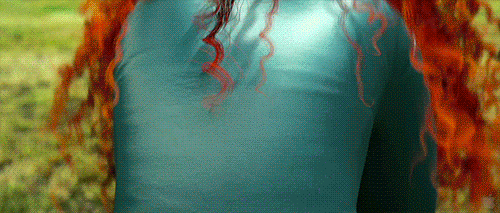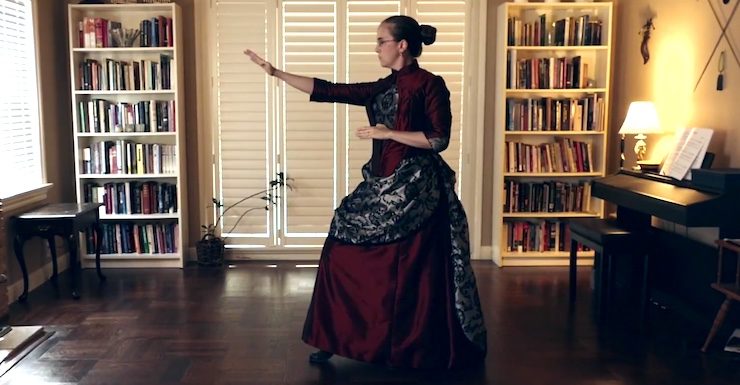When Mary Robinette Kowal and I were on tour together, she asked me to record something for a charity fundraiser: a video of me performing a karate kata in the Victorian dress I wore for our tour events.
Being an author, of course I said yes.
Because it immediately made me wonder—what would that be like? How well could I do karate in that dress? What sorts of difficulties would I run into? And how could I make use of this experience in a story someday? I had some suspicions, but without putting them to the test, I couldn’t be sure. Mary and I were on the way to our next event when she made the request, so after we arrived and got into costume, I decided I would take a moment to walk through a simple kata as a preliminary test.
I got one move in and discovered that the biggest limitation was one that had never even crossed my mind.
It wasn’t the skirt.
When you talk about this kind of thing, most people’s minds go first to the skirt. After all, that’s the most obvious difference between men’s clothing and women’s. And let’s be clear: a skirt is something of a liability when fighting. The kata I chose to perform has only one kick in it, at the very end; that was a deliberate choice on my part, because any time I pick my foot up, I risk catching my heel in the hem on the way down. This might cause me to stumble, or possibly even rip the hem and create an ongoing trip hazard for the rest of the fight.
But contrary to what movies would have you believe, kicks aren’t a huge part of most practical fighting. They’re slow—which means your opponent has more time to see you coming and do something about it—and they put you in an unstable position, balancing on one foot, vulnerable to being knocked down. So the fact that kicks in a dress are hazardous isn’t as big of a deal as you might think. On the other hand, if you wind up on the ground during the fight, the odds of restricting your own movement because you’re kneeling on your skirt? Those are much higher. I don’t practice Brazilian jiu-jitsu, but I suspect doing that style in a dress is a pretty bad idea.
Since my style doesn’t incorporate ground fighting, I figured my skirt wouldn’t really be much of a problem. If it created any issues, I expected them to be much subtler, with the fabric tangling around my legs as I stepped. This wouldn’t be enough to trip me or anything dramatic like that, but it could still interfere with my movement. The style of karate I practice, though, is shōrin-ryu. This emphasizes very straight, minimalist steps, almost always taking your foot in the most direct line from its current position to its new one—which turns out to be ideal when you’ve got a lot of fabric along for the ride. It’s possible I’d have more trouble if I practiced shotokan karate instead, with its sweeping, crescent-shaped steps; those seem tailor-made (if you’ll pardon the pun) for skirt troubles. As it stands, though, I have no trouble with ordinary footwork when dressed up like a late Victorian lady.
It wasn’t the corset, either.
The next most obvious candidate for sartorial difficulty is the corset. The dress I wear when on tour for the Memoirs of Lady Trent isn’t a completely period-accurate late Victorian outfit; the costumer who sewed it for me designed it look outwardly appropriate, while being a little more friendly to the life of a modern woman—particularly one who would need to carry it on airplanes and get dressed without help in the stock room of a bookstore. Because of that, it doesn’t have a corset in the traditional sense; instead it has a back-lacing sleeveless bodice and a jacket that hooks over it. Both of these have a fair amount of boning in them, though, which means the effect is much the same.
As with the skirt, I’ll grant that a corset can indeed be a liability. If the boning is made of wood or whalebone, it could get broken by a hit, which might mean your own clothing winds up stabbing you. (On the other hand, a sufficiently well-constructed set of stays would actually help armor you against slashing attacks.) A lot depends on the time period: in late seventeenth-century England, the busk at the front of the corset could extend all the way to the lady’s “honour,” which sounds like it would make even sitting uncomfortable, let alone any more vigorous movement. But if your fighting style doesn’t emphasize grappling, the fact that you can’t really bend through the waist isn’t necessarily going to be a big deal. So is the corset really a problem?
I’ll be honest with you: I thought this, not the skirt, would be the main problem. Not because I need to bend through the waist to do my kata, or even because the boning might dig in uncomfortably; once again, I expected the problem to be subtler. I’ve been studying karate for eight years, and I’ve spent that time learning how to generate force with my entire body. When I punch, it isn’t just an arm movement; the power starts with my footwork, my knees, my hips, my opposite arm, using the torque of my whole body to drive my fist forward.
Now put a cage around the middle of that equation.
I thought it would be like trying to play piano with gloves on. Sure, I can still perform the motions… but the subtlety and the fine control would be gone, muffled up by the interference of clothing. And it’s possible that’s exactly what happened. But I can’t really tell you, because any difficulty I had with my corset was instantaneously drowned out by the real problem—the one that yanked me up short before I finished even the first movement of the first basic kata.
It was the sleeves.
The sleeves? The things wrapped around your arms? How on earth could those be a bigger problem than skirts and spring steel boning?
Because of the armholes. When my seamstress was designing my costume, she told me that she would cut the jacket to be more forgiving than usual for period style, because I would need a greater range of movement through my shoulders than an actual upper-class Victorian lady would expect. Even with a more generous cut, though, my ability to move my arms in this costume is limited; I can’t raise them much above ninety degrees. And, most fatally for my ability to do karate, I can’t reach very far forward.
If you were to come to a class at my dojo, one of the most common things you would hear the sensei telling the students is, “Deep cross!” Half of our blocks begin by crossing your arms in front of yourself. We talk about folding your upper body (disregarding the fact that ribs and a sternum mean you can’t actually fold yourself in half) and then snapping open again, using that wind-up to generate power. Even when a movement doesn’t begin with a deep cross—a punch, for example—you let your shoulder come forward briefly before settling back.
Trying to do karate in that dress is like being a dog on a choke leash. Time and time again, the fabric stops me short, the satin across my upper back pulling taut and halting my movement before it’s complete. I can’t get anywhere. Or rather, I can… in a pathetic, limited manner that doesn’t carry even half of my usual force. Trying to do a deep cross in that jacket makes me feel like a T-Rex, my arms shortened to uselessness.
What’s interesting about this is that it isn’t an issue specific to women’s clothing. Men’s clothing is more likely to be forgiving in the shoulders, but not always; there have been places and time periods that favored a close-fitting silhouette, on the assumption that a gentleman isn’t engaging in the kind of vigorous labor that would make such a cut impractical. (Like a lady, he has people to do that sort of thing for him.) Men have worn corsets, too, and articles of clothing with something you might call a long skirt, but the sleeves are the point at which they’re most likely to run into trouble. When you see a man in a film taking off his coat before he fights a duel, he isn’t just protecting the nicer fabric against getting torn and dirty; he’s giving himself more freedom of movement.
See for yourself what the effect is:
I didn’t choose arakaki sochin because it’s my best kata (it isn’t), but because it has no “deep cross” moments. Despite that, those of you with an eye for martial arts may be able to tell that my punches in the opening sequence aren’t quite up to snuff, because of how the jacket stops me from really bringing my shoulder forward like I should. The rest of the kata is less affected for the most part, but there are a few points where the clothing interferes at least a little. And I paid a price for it, too: I went through the kata in full costume three times that day, once as a warm-up, and then two takes of filming, and when I changed back into modern clothing I found red marks down the fronts of my shoulders where the seams had bit in.
The Takeaway
As a karateka, I’m not very pleased with my performance—but as a writer? It was a fascinating experience, one that left me with a lot of thoughts about fight scenes in fantasy novels. Clothing and behavior go in a feedback loop: if gentlemen in your invented society expect to be jumped by assassins in the street on a regular basis, they’re going to wear coats that allow a larger range of movement, because they can’t expect the enemy to wait while they shuck their restrictive outer layer. Coming at it from the other direction, if your fantasy ladies are trained to defend themselves while also looking decorative, they’ll probably learn a style much like mine, with relatively little in the way of kicks or ground fighting and straight-line movement that won’t send their skirts into a tangle.
And when it comes to the sleeves… well, I’ll let Merida show us how it’s done:

In the end, I couldn’t punch well in this kata because I didn’t want to ruin my costume. But if I were fighting for my life, that consideration wouldn’t even cross my mind. I’d move with full force and see which is stronger: my seams or my body. I’d come out the other side with a ruined jacket and some really impressive bruises along my shoulders—but at least I’d have a chance of staying alive.
This article was originally published in May 2017 as part of our Related Subjects series.
 Marie Brennan is the author of multiple series, including the Varekai novellas, the Onyx Court, the Wilders, and the Doppelganger duology, as well as more than forty short stories. Within the Sanctuary of Wings, the fifth and final book of the Lady Trent series, is available from Tor Books. More information can be found at her website.
Marie Brennan is the author of multiple series, including the Varekai novellas, the Onyx Court, the Wilders, and the Doppelganger duology, as well as more than forty short stories. Within the Sanctuary of Wings, the fifth and final book of the Lady Trent series, is available from Tor Books. More information can be found at her website.










